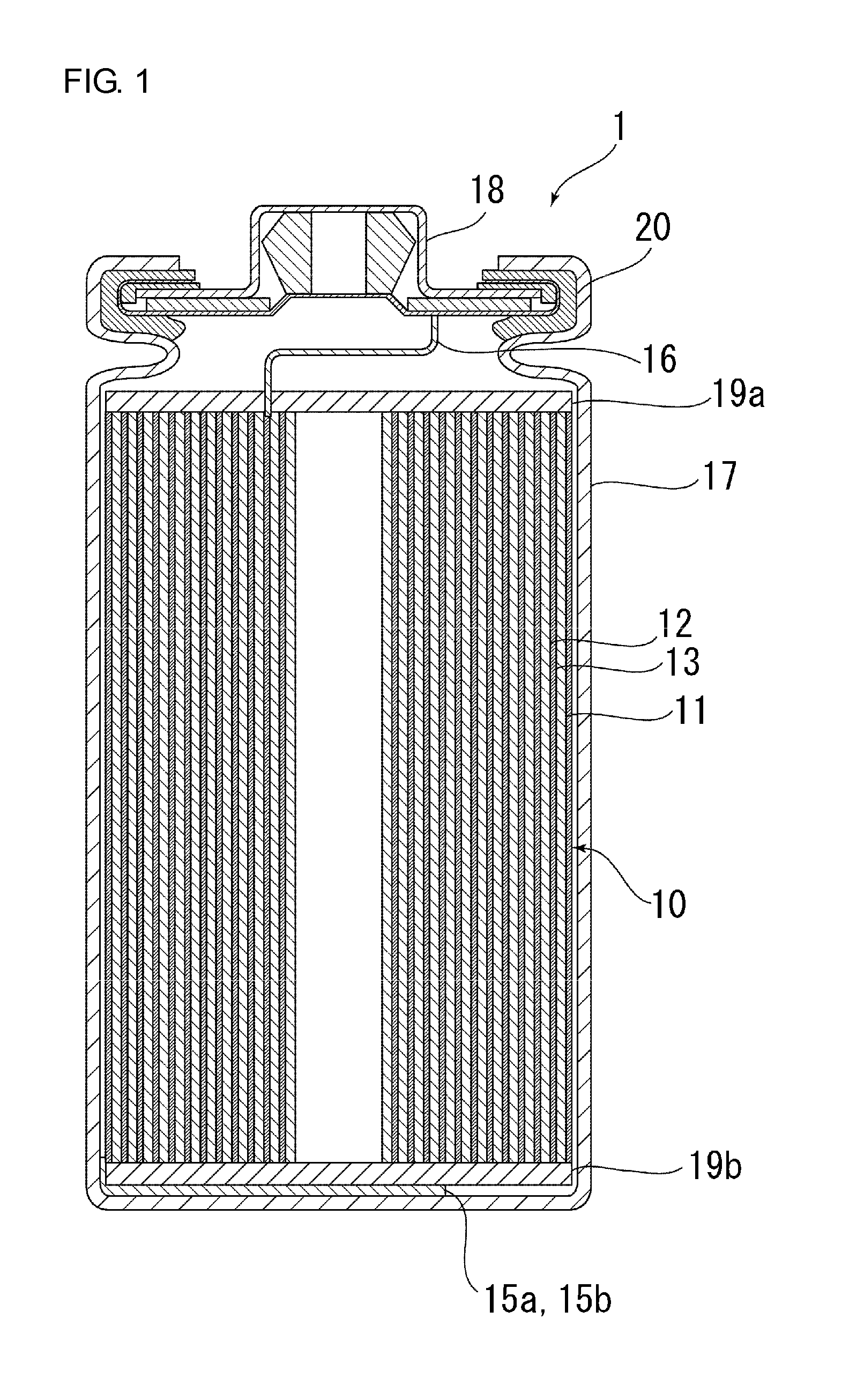Lithium secondary battery
a secondary battery and lithium battery technology, applied in the field of lithium secondary batteries, can solve the problems of poor charge-discharge cycle performance of lithium secondary batteries using negative electrode active materials that are alloyed with lithium, large volume change in occlusion/release of lithium, etc., and achieve the effect of less deformation, improved charge-discharge cycle performance, and reduced pressure on separators and other components
- Summary
- Abstract
- Description
- Claims
- Application Information
AI Technical Summary
Benefits of technology
Problems solved by technology
Method used
Image
Examples
first embodiment
[0044]FIG. 1 is a schematic cross-sectional view of a lithium secondary battery according to a first embodiment. FIG. 2 is a schematic perspective view of an electrode assembly according to the first embodiment. FIG. 3 is a schematic plan view of a developed negative electrode in the first embodiment. FIG. 4 is a schematic cross-sectional view taken along line IV-IV in FIG. 3. FIG. 5 is a schematic plan view of a developed positive electrode in the first embodiment. FIG. 6 is a schematic cross-sectional view taken along line VI-VI in FIG. 5. It is noted that in FIGS. 3 and 5, and FIGS. 7-9 and 11 set forth below, for illustration purpose, a region where an active material layer is formed and a region where a connecting member is arranged are shown by hatching.
[0045]As shown in FIG. 1, the lithium secondary battery 1 comprises an electrode assembly 10. The electrode assembly 10 is formed by winding a negative electrode 11 shown in FIG. 3, a positive electrode 12 shown in FIG. 5, and ...
second embodiment
[0097]FIG. 7 is a schematic plan view of the developed positive electrode in a second embodiment. FIG. 8 is a schematic plan view of the developed negative electrode in the second embodiment;
[0098]In the above first embodiment, there has been described the case where the negative electrode 11 is divided into the plurality of electrode units while the positive electrode 12 may be integrally formed. However, the present invention is not limited to this configuration. For example, the positive electrode 12 may be divided into the plurality of electrode units while the negative electrode 11 may be integrally formed.
[0099]In the present embodiment, the positive electrode 12 comprises first and second positive electrode units 12A, 12B which are arranged in the winding direction, as shown in FIG. 7. The first and second positive electrode units 12A, 12B have the positive electrode current collector 12a and the positive electrode current material layers 12b, 12c which are described in the f...
third embodiment
[0106]FIG. 9 is a schematic plan view of the developed positive electrode in a third embodiment. FIG. 10 is a schematic cross-sectional view taken along line X-X in FIG. 9.
[0107]In the above second embodiment, there has been described the example where the positive electrode active material layers 12b, 12c are formed on substantially all the surfaces of the positive electrode current collector 12a in each of the electrode units 12A, 12B. However, the present invention is not limited to this configuration.
[0108]For example, as shown in FIGS. 9 and 10, the positive electrode active material layers 12b, 12c may be formed on only a part of the positive electrode current collector 12a. In the present variation, the positive electrode active material layers 12b, 12c are not be provided on the connected portion by the connecting member 14. The connecting member 14 is adhered or bonded to the positive electrode current collector 12a. Therefore, the peeling off of the positive electrode acti...
PUM
| Property | Measurement | Unit |
|---|---|---|
| surface roughness Ra | aaaaa | aaaaa |
| thickness | aaaaa | aaaaa |
| thickness | aaaaa | aaaaa |
Abstract
Description
Claims
Application Information
 Login to View More
Login to View More - R&D
- Intellectual Property
- Life Sciences
- Materials
- Tech Scout
- Unparalleled Data Quality
- Higher Quality Content
- 60% Fewer Hallucinations
Browse by: Latest US Patents, China's latest patents, Technical Efficacy Thesaurus, Application Domain, Technology Topic, Popular Technical Reports.
© 2025 PatSnap. All rights reserved.Legal|Privacy policy|Modern Slavery Act Transparency Statement|Sitemap|About US| Contact US: help@patsnap.com



